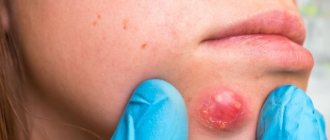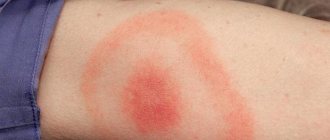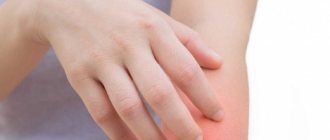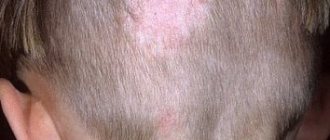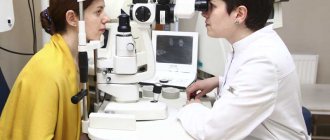Dermatovenerologist
Khasanova
Alina Rashidovna
8 years of experience
Make an appointment
Folliculitis is an infectious process that develops in the middle and deep parts of human hair follicles. The pathology is accompanied by the formation of multiple pustules with purulent contents. The causative agent of the disease can be bacteria, viruses, fungi and parasites. As the infection progresses, the number of pustules on the patient's skin increases. When the primary lesion is opened, ulcers form, and when they heal, small scars form.
general information
The pathology is widespread among residents of countries with high humidity and air temperature. Such climatic conditions contribute to the spread of infectious lesions of the hair follicles. The risk group is represented by socially disadvantaged segments of the population: a person’s failure to comply with the rules of personal hygiene leads to the active reproduction of pathogens on the skin.
Often the causes of folliculitis are superficial inflammation of the follicles - ostiofolliculitis. The spread of infection to the lower parts of the follicle leads to the formation of purulent pustules.
Preventive measures for pseudomonas folliculitis
To speed up the recovery process and prevent a relapse of the disease, you need to take preventive measures:
- Swim in water that has been pre-treated with chlorine
- Do not take hot baths for a long time.
- Do not use substances with a high concentration of alkali to treat leather.
- Do not use other people's towels, hygiene and bath accessories.
- Disinfect sensitive and irritated skin.
- Increase the body's immune defense. Use vitamin and mineral complexes and carry out physiotherapeutic treatment methods.
- Ultraviolet irradiation has a positive effect on the skin. UHF therapy and exposure to short ultraviolet waves have proven themselves well.
- Carry out antiseptic treatment of microtraumas with alcohol solutions.
- For other diseases (diabetes mellitus, gastrointestinal pathology, endocrine disorders, immunodeficiency state), carry out proper treatment of the underlying disease.
Share this article:
Reasons for the development of pathology
In 70% of cases, inflammation of the hair follicles develops under the influence of staphylococci and streptococci. Somewhat less frequently, the causes of the disease are pseudomonas, pathogens of syphilis and gonorrhea, or Candida fungi. Molluscum contagiosum and herpes zoster viruses are less common causes of folliculitis. About 10% of clinically recorded cases of inflammation of the hair follicles occur due to the activity of parasitic mites Demodex folliculorum and Demodex brevis.
Pathogens enter the follicles through damaged areas: scratches and abrasions. People suffering from itchy dermatitis and excessive sweating are susceptible to infection. The weakening of the patient's immunity leads to the penetration of infection into the hair follicles. For this reason, dermatologists recommend taking preventive measures for men and women with diagnosed diabetes and chronic infections. The disease often occurs in HIV-infected people and patients taking immunosuppressive drugs.
Types of pathology
In the process of diagnosing folliculitis, dermatologists determine the form of the disease that the patient suffers from. Thus, the staphylococcal type of pathology is often localized on the face of men, affecting the chin and the skin around the lips. Infection occurs during the process of shaving stubble hair.
The pseudomonas form of the disease occurs as a result of the patient bathing in hot water with an insufficient level of chlorination. The heat helps open the pores into which infectious agents enter. Foci of inflammation form on the face and upper torso of a child or adult.
The syphilitic type of pathology develops against the background of secondary syphilis. Typical symptoms of this form of folliculitis are the formation of areas of bristly hair loss in men and multiple pustules on the temples in women.
The herpetic type of hair follicle infections affects the skin of the chin and nasolabial triangle of patients. Characterized by the formation of large vesicles in the follicular ostia.
The candidal form of pathology manifests itself when occlusive dressings are applied to the patient’s skin, preventing pathogenic microflora from entering the wound on the chest.
The gonorrheal type of disease becomes a complication of gonococcal infection. Pustules form in the perineum (in women) and on the foreskin (in men).
Folliculitis caused by mites can be localized on any part of the human skin. The activity of Demodex folliculorum and Demodex brevis leads to the formation of clusters of small pustules.
Symptoms of pathology
Symptoms of folliculitis in men and women are the same in most forms of the disease - dermatologists prescribe similar treatment for patients of both sexes. The most pronounced sign of an infectious lesion of the hair follicle is a single pustule filled with purulent contents, the center of which is penetrated by hair. After several days, the formation opens on its own, releasing a small amount of pus. In place of the pustule, an ulcer with a dense bloody-purulent crust forms. Healing of the resulting wound leads to the formation of a focus of hyperpigmentation or scar.
In 80% of clinically diagnosed cases of the disease, multiple pustules form on the skin of patients. Common places for their localization are the face, scalp, armpits, pubis, and inner thighs. Severe pain and itching appear after the formation of a large cluster of pustules. In the absence of medical care and refusal to observe personal hygiene rules, the patient may encounter complications: abscesses, cellulitis and hidradenitis.
Materials and methods
Study design
A retrospective multicenter study was conducted that included patients with folliculitis decalvans followed for at least 5 years. The study included patients from 9 Spanish clinics, observed there between 1995 and 2015. The diagnosis of folliculitis decalvans was confirmed histologically in all cases.
The following information was entered into the database: epidemiological (age, gender, race, family history, associated triggers), clinical (age of disease manifestation, lesion size, affected area, complaints, objective symptoms, changes in laboratory parameters), diagnostic (pathohistological results research and culture of discharged pustules from foci of alopecia, as well as discharge from the nose), therapeutic (treatment performed, response to therapy and duration of response, adverse reactions).
As in the study by Vano-Galvan and colleagues, the severity of folliculitis decalvans was assessed based on the maximum diameter of the largest alopecia lesion and was divided into 3 categories: 1 - moderate (up to 2 cm), 2 - moderate (2 - 4.99 cm), 3- heavy (more than 5 cm). Symptom severity was assessed as: asymptomatic, occasional symptoms, daily symptoms.
Response to therapy was assessed as an improvement in symptoms and inflammatory changes greater than 75% in the absence of an increase in alopecia lesions. Efficacy was assessed during scheduled patient visits once every 2-3 months. To assess the economic significance of the disease, monthly costs associated with treatment (cost of medications, private visits to specialists, costs of cosmetic treatment) were assessed.
The patient's quality of life was assessed according to the Dermatology Life Quality Index. Also, the 12-Item Short Form Health Survey, version 1, was used. It allows you to assess the patient’s quality of life according to 12 parameters and determine the degree of psychological well-being (mental health) and functional capabilities (physical health).
Statistical analysis
In descriptive analysis, data are presented as a mean with standard deviation, median, or raw data, depending on whether they have quantitative or common variation and depending on the nature of their distribution. To assess qualitative variation, Student, Mann-Whitney, and Kruskal-Wallis coefficients were used. Differences in qualitative variation were assessed using x2, probability level, and Fisher's test as appropriate. Two multiple logistic regression models were performed with post hoc estimation. The criteria for selecting variation in the models were the following: relevance of the collected scientific literature, clinical criteria of the author, relevance found in the previous analysis of variation. A P coefficient of less than 0.05 was considered statistically significant. SPSS Statistics (version 21, IBM Corp, Armonk, NY) and Stata v14 (StataCorp LP, College Station, TX) programs were used for data analysis.
Diagnostics
The diagnosis is made by a dermatologist. The doctor examines the patient, during which he performs dermatoscopy. Studying damaged hair follicles using an optical device allows us to determine the depth of penetration of pathogens into the structures of the dermis. Samples from pustules obtained during the examination are subjected to laboratory testing. The study of biomaterials in the laboratory is carried out to identify the causative agent of infection. If signs of gonorrhea or syphilis are detected, the doctor will refer the patient for PCR testing.
Differential diagnosis allows doctors to exclude drug-induced toxicoderma, pityriasis rosea, streptococcal impetigo, furunculosis and ostiofolliculitis from the patient’s history.
Treatment
The treatment tactics for folliculitis are determined by the doctor, taking into account the type of disease identified in the patient. For bacterial types of pathogens, antibiotic ointments are recommended for adults and children. The fight against fungal pathogens is carried out using antifungal agents. Antiviral drugs are used to combat the herpetic form of the disease.
Local therapy for the treatment of folliculitis localized on the face is effective at the initial stage of the disease. If multiple pustules appear, the patient will need to treat the rash with alcohol solutions of brilliant green or fucarcin. The spread of infection can be stopped by regularly treating the skin with salicylic or boric alcohol. Ultraviolet irradiation of the body and limbs of a child or adult becomes an auxiliary therapeutic measure.
The complicated course of the pathology requires complex therapy aimed at treating the disease that is the root cause of folliculitis - gonorrhea or syphilis.
Symptoms of pseudomonas folliculitis
Photo of pseudomonas folliculitis appearing on the skin
Pseudomonas folliculitis affects children more often than adults because they spend longer in water. The disease begins to manifest itself within 8-48 hours (less often 72 hours). There is no spread of infection from person to person.
The symptoms of the disease are as follows: itchy lesions and uniform round red rashes with a papule or pustule in the center appear on the body. Rashes can be single or multiple. In areas of compressed skin, the rashes are more intense. This happens more often when wearing closed, tight-fitting swimsuits. In the acute form, a high temperature rises, signs of intoxication, general malaise and weakness appear. The skin becomes more sensitive.
With progressive “hot bath” folliculitis, the rashes fester. Then the papules are opened to release the contents. The wounds are covered with a crust, which peels off over time, and the affected areas are restored with proper treatment. If folliculitis is accompanied by a secondary infection or it becomes protracted, then the purulent-inflammatory processes intensify.




